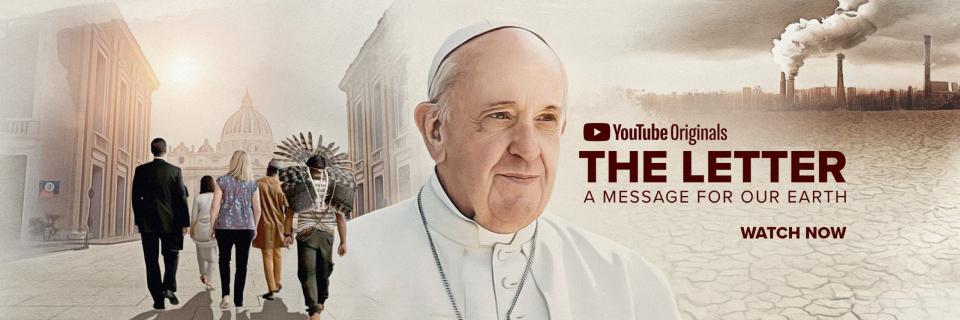Fr. John Sivalon, MM, Professor of Religion at University of Scranton, describes the new YouTube Original documentary “The Letter” as a message to each of us for collective, transformative action on climate change.
The following article was published in the November-December 2022 issue of NewsNotes.
Sandwiched between an early introduction to Bilal “Billy” Seck, a Senegalese youth, and a last video message by Billy before he lost his life crossing to Europe in an overloaded boat, a new film entitled “The Letter” chronicles the journey of five individuals (Arouna Kande’, Chief Dada, Ridhima Pandey, and Drs. Greg Asner and Robin Martin) who were invited to participate with Pope Francis in a dialogue at the Vatican and Assisi. The five were chosen for their work promoting integral ecology and to represent groups most vulnerable to climate change.
One represents Indigenous people, one youth, one the poor, and two scientists represent the voice of nature and wildlife. As their stories unfold, the film’s images accentuate the beauty and diversity of nature both on land and in the sea. It also highlights the scarring of that beauty and the destruction of nature’s biodiversity that is threatening our future and is the current source of climate change migrants.
As Laudato Si’ itself did, this film challenges us to look beyond our comfortable and well-manicured campus to the pain and devastation that is being inflicted on the Earth and the most vulnerable. It provokes us to examine how our lives are connected to that suffering, pain, and degradation. And it challenges us to move beyond empathy and concern to action.
Chief Dada of the Maro people living in the Amazon region of Brazil, calmly describes his struggle to protect the Amazon rainforest. He describes it as his people’s home, a beautiful home. But in 2002, logging companies began to occupy the land and manage it for their profit.
In the face of losing their home, the Maro people began to organize, resist, and defend their land. “Last year, 212 people lost their lives standing up for their land” as reported in the film. This segment is particularly striking, knowing that the retirement plans of faculty and staff of the University of Scranton, including my own, are managed by TIAA-CREF. See https://bit.ly/FarmLandGrabReport for an explanation of the company’s role in agribusiness in Brazil.
The voice of the poor is emotionally expressed in the film by Arouna, a self-described climate refugee. He talks about the dual effects of climate change on the people of Senegal. The Sahel is encroaching from the east and the rise of ocean levels is eating away the shoreline of the west.
Because of climate change many Senegalese have lost their homes and farms. The film indicates that experts predict that by 2050, as many as 1.2 billion people could be displaced by climate change. Arouna explains that this is why young people are risking their lives to emigrate to Europe. Arouna’s gift to the pope was a metal sculpture of an overloaded boat. A stark reminder to us that the migrants trying to get to our land are human beings with profound stories of struggle and courage.
From Haridwar, India, Ridhima Pandey epitomizes the pope’s optimism that it is the new strength and energy of young people that can bring change. The film witnesses her networking with youths across the world to mobilize despite government and corporate leaders’ failure to act.
A friend in Australia describes to her in a video call the very moments when she and her family flee their home as a bush fire rages towards them. As the family gathers their chickens and dogs, the film indicates that 3 billion animals were killed or harmed in Australian bushfires from 2019 to 2020. Ridhima recalls her own experience of flooding in India and how that experience led her to join others to advocate for change, knowing it is her generation that will be the most impacted if nothing is done.
The husband-and-wife team of scientists from Hawaii describe their research into the troubled state of coral reefs. Robin calls coral reefs “the rainforest of the sea.” She says, “They provide habitat, they provide food, and they provide shoreline protection.” While several factors may be threatening the coral reefs, both Robin and Greg emphasize the role of marine heat waves. Most frightening is that a new heatwave has begun, and if there is just another 2-degree Celsius rise in global temperature, we could lose 99% of the Earth’s coral reef. In this dire state, Robin says that science alone cannot solve this problem. People, all people, need to come together to solve it.
The film’s emphasis is that this letter (Laudato Si’) was written to all people. It stresses that care of the Earth and care of one another is central to all religions. It references, through various scenes and images, Islam, Buddhism, Hinduism, Indigenous, and Judeo-Christian traditions.
The production of this film is a clear indication of the Vatican’s commitment to our common home and its commitment to reach out to as broad an audience as possible. It is meant, as Pope Francis says, to move us out of our patterns of comfort to imagine something different for our common home and to act on it.
Faith in action: Watch The Letter on Youtube at https://youtu.be/Rps9bs85BII
Photo: screengrab from The Letter video on YouTube

